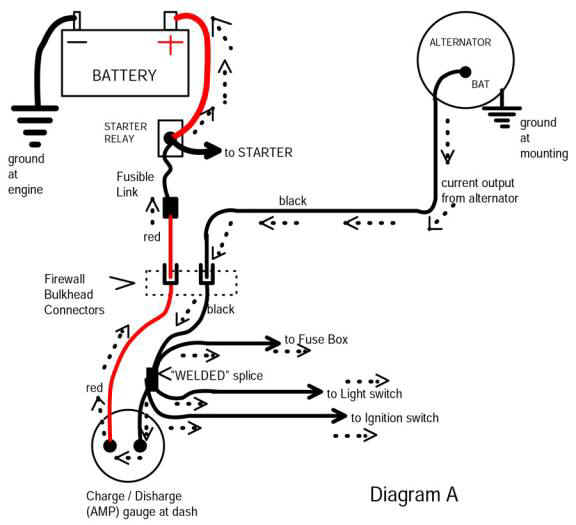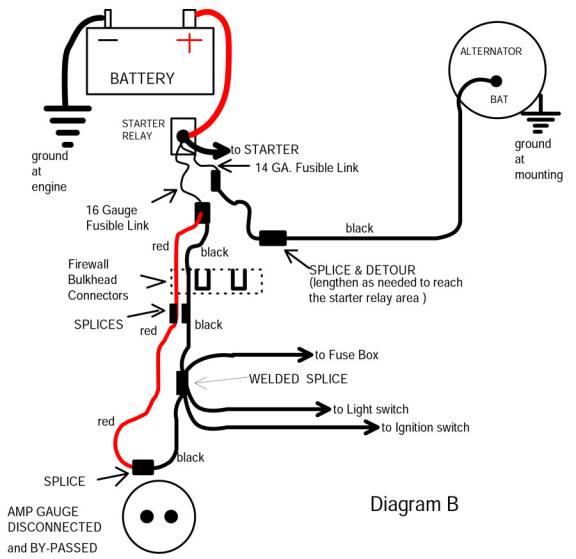Page 1 of 1
Ammeter bypass - over thinking, or over simplifying
Posted: Sun Mar 19, 2023 2:50 pm
by Moparmikeo
In typical 1 thing leads to 10, I noticed the feed wire coming off the alternator was run close to the manifold, and is getting crispy. Looking through the ammeter threads, eliminate the existing wire, run a new 12 GA wire with a 14 fusible link to the B terminal on the solenoid, and done. Seems like I'm missing something...
Thanks in advance!
Re: Ammeter bypass - over thinking, or over simplifying
Posted: Sun Mar 19, 2023 4:32 pm
by tgreese
Year, model, equipment? Vital to this question. Can't say anything without that. Original alternator? Original regulator?
Re: Ammeter bypass - over thinking, or over simplifying
Posted: Sun Mar 19, 2023 6:35 pm
by Rc4mike
Good question. I was about to do the same to my 84 waggy
Re: Ammeter bypass - over thinking, or over simplifying
Posted: Sun Mar 19, 2023 9:03 pm
by Moparmikeo
tgreese wrote: ↑Sun Mar 19, 2023 4:32 pm
Year, model, equipment? Vital to this question. Can't say anything without that. Original alternator? Original regulator?
Oops...
82 wagoneer Limited, stock electrical.
Re: Ammeter bypass - over thinking, or over simplifying
Posted: Mon Mar 20, 2023 7:32 am
by tgreese
An '82 came with the Delco 10SI (systems integrated) alternator. The regulator is inside the alternator. Normally the charge wire (big wire) goes from the alternator, across the top of the firewall, through the bulkhead connector, feeds the dash and lights, through the ammeter, back to the bulkhead connector, back across the top of the firewall, through a fusible link and connects to the batery via the starter solenoid.
You can connect the alternator directly to the battery. This will bypass the ammeter since current will no longer flow through it. Usually you would put an additional fusible link in the new wire, at the solenoid.
The original wire is 10 ga, not 12 ga. 12 ga is undersized here. I'd pick a fusible link 2 sizes smaller (ie a reduction of 4 in gauge). For a 10 ga wire, I'd use a 14 ga fusible link. Or a 16 with 12. You want a small enough link that it will fuse before the wire melts. This will protect you from a car fire if one of these big wires connects to ground in a wreck or whatever.
In addition to your new wire, I would remove the original wire that went from the alternator to the dash, and bypass the ammeter. This would keep the factory fusible link between the solenoid and the ammeter. Then the original wire from the alternator to the dash can be removed, or abandoned in place. On my '82, I released that wire from the bulkhead connector and removed it.
Note the original wire from the alternator to the bulkhead connector is 10 ga and 5-6 feet long. I would expect the part that's in the harness and going across the top of the firewall to be in good shape. Once you remove it, you can use it as your new bypass wire to the solenoid. That's what I did for my '82.
If you put your year/model/equipment in your signature file, it will be attached to every one of your posts.
Re: Ammeter bypass - over thinking, or over simplifying
Posted: Mon Mar 20, 2023 7:50 am
by tgreese
Rc4mike wrote: ↑Sun Mar 19, 2023 6:35 pm
Good question. I was about to do the same to my 84 waggy
Note that other years are not necessarily the same. An '84 is probably the same as an '82 if it has an ammeter. Suggest you compare the wiring diagrams in your TSM to my description above.
What I wrote above will only apply if you have an ammeter in the dash and your Jeep came with the Delco SI-type alternator. Earlier models are way different, and the sixes got the Delco sooner. Early sixes and V8s got the Motorola alternators with a solid state regulator on the inner fender, and a few years V8s got the Motorcraft alternator with a mechanical (coils and contacts, like relays!) regulator. Different! and a candidate for conversion to the much superior Delco SI. Later models without an ammeter do not need a bypass.
Re: Ammeter bypass - over thinking, or over simplifying
Posted: Mon Mar 20, 2023 12:21 pm
by letank
Re: Ammeter bypass - over thinking, or over simplifying
Posted: Mon Mar 20, 2023 2:23 pm
by will e
When I upgraded to Cs140 on my 83 I ran a big fat wire from the alternator to the battery. I didn't bypass the original wiring. My amp meter doesn't read any charge or discharge.
Re: Ammeter bypass - over thinking, or over simplifying
Posted: Thu Apr 06, 2023 12:37 pm
by marc
Looking at the diagram, I am confused about the need for the loop between of the two old ammeter wires. Given they are drawing from the same source, in my ignorance I thought connecting with two wires would not increase the available power just decrease the load on each wire. I would have thought the red or the black wire could be eliminated, cut at the welded splice?
Re: Ammeter bypass - over thinking, or over simplifying
Posted: Thu Apr 06, 2023 2:43 pm
by tgreese
You do not need a loop. The loop is there because the original circuit was a loop. With an ammeter, all the current went up to the dash, went through the ammeter, and back to the battery. This makes a loop.
When you remove the ammeter, there is no need for the loop. The alternator current must reach the battery. The battery current must reach the dash and lights. However you wire that is ok.
That said, having the two big wires feed the dash and lights does not hurt anything - it's just redundant.
Also, black and red are the colors for a Dodge, not Jeep. That drawing is for a Dodge. A Jeep typically is yellow and red for these wires. Suggest your look at the factory wiring diagram for your Jeep and draw it out.
Re: Ammeter bypass - over thinking, or over simplifying
Posted: Sat Apr 08, 2023 9:00 pm
by Moparmikeo
Mission accomplished, thanks for the guidance. Disconnected the red wire from the alternator and bulkhead connector. New 10 gauge and 14 gauge fusible link from alternator to starter solenoid. Started up, and charging as it should. Now to finish the headlight relay wiring!

